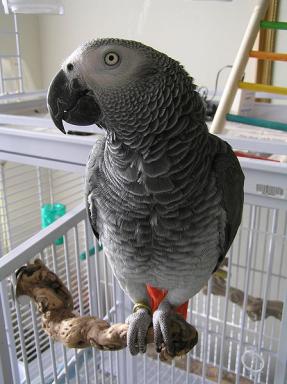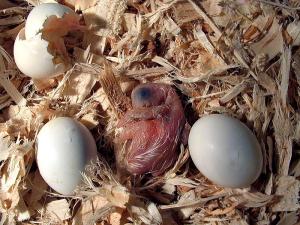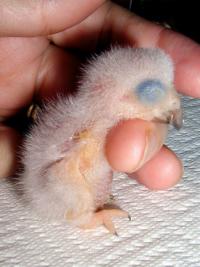African Grey Parrots

While African grey parrots (Psittacus erithacus) may not be the most colorful of parrots, they are fun birds to keep because of their superior intelligence and winning personalities.
African grey parrots are rather expensive birds. Prices generally range from about $250-1000. However, most African grey owners feel these birds are worth the price because of their excellent personalities and trainability. If properly cared for African greys can live for over 30 years.
Many of you may be familiar with "Alex," the intelligent parrot trained by Dr. Irene Pepperberg. Her work with Alex and other African greys has redefined the term "birdbrain".
In fact, most experts agree that African greys function at a level similar to a three-to-five-year-old human child.
Unfortunately, Alex passed away on Sept 12, 2007. He was 31.
Dr. Pepperberg's work on bird cognition continues, although Alex was especially bright. For more information about Irene Pepperberg's work please visit The Alex Foundation.
To see a demonstration of another parrot trained by Dr. Pepperberg answering questions about different objects please watch the You Tube video below.
As you can tell from the video, African Greys are intelligent birds and can even make statements regarding their wishes.
Housing an African Grey Parrot
Because African Greys are so intelligent, they will need a lot of stimulation and need to be kept in a location where they will receive lots of attention and be able to view lots of activity. However, the kitchen is a bad place to keep your bird's cage because the fumes from teflon pans are toxic to birds.
Your African grey parrot should spend a large portion of time out of his or her cage. However, be careful to take the necessary precautions not to let your parrot escape though open doors or windows.
Although your African Grey should spend most of its time out of its cage, you should still buy the largest cage you can afford. The minimum sized cage to house one African grey parrot is about 36 inches (L) x 36 inches (W) x 60 inches (H) and remember bigger is always better.
You will also need to provide your African grey parrot with lots of toys. Your African grey should have an enriched environment if you want her to reach her full intellectual potential.
Feeding Your African Grey Parrot
Like all pet birds, African greys need variety in their diet. Pelleted diets are best, but if your bird is used to eating seeds it is often difficult to make the switch to a pelleted diet.
You should provide lots of fresh fruits and vegetables each day. Your African grey can also eat grilled or broiled chicken and/or chopped up hard boiled eggs.
You should also provide cuttlebone for them as a calcium source.
Don't feed them chocolate, avacado, or onion.
Sexing Your African Grey Parrot
To be absolutely sure of the sex of your African grey parrot you will need to have your bird DNA tested or surgically tested. However, there are ways to visually sex your African greys. To see photos of male and female African greys, as well as a description of how to sex them by simply looking at them visit Visual Sexing African Greys.
Breeding African Greys
African greys are not too difficult to breed. Some of the best articles I've seen on breeding African greys can be found here: Breeding African Greys and A Beginner's Observations On Breeding African Grey Parrots.
Please see below for a picture of African grey eggs and chicks (newly hatched) and a one day old African grey chick so you'll see what you'll get for your efforts.


Pretty sweet little birds, aren't they?!
